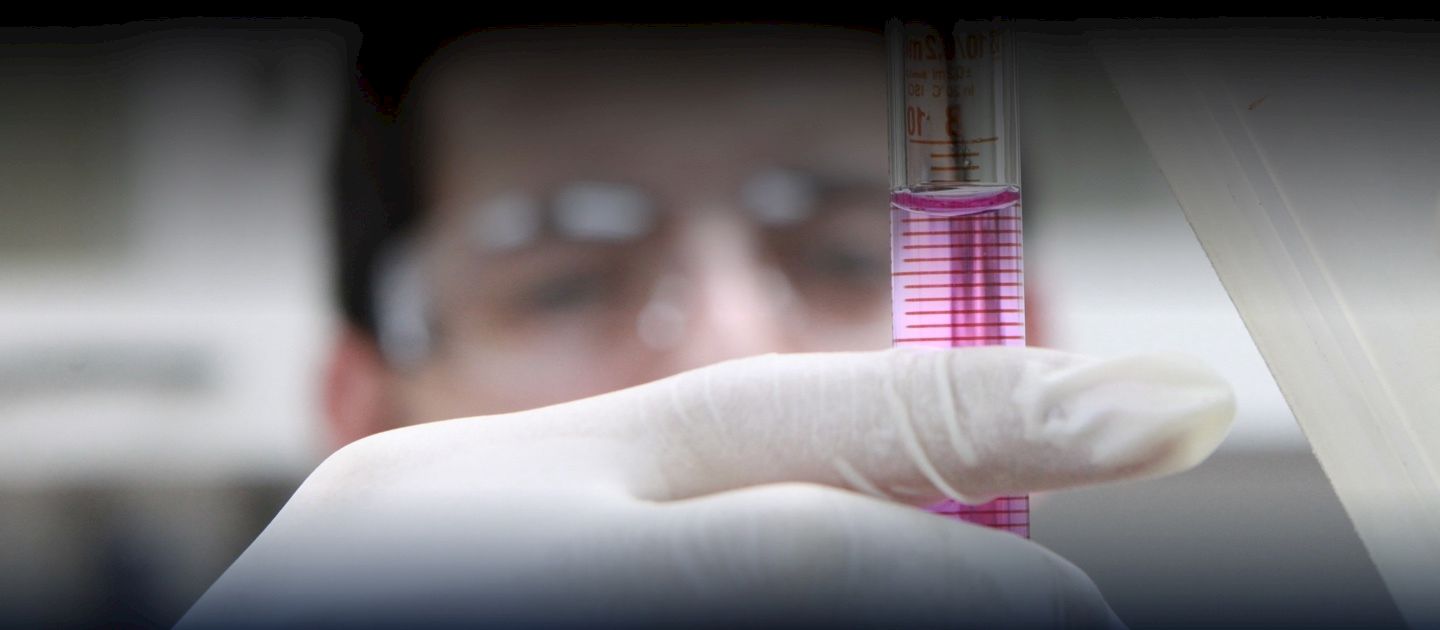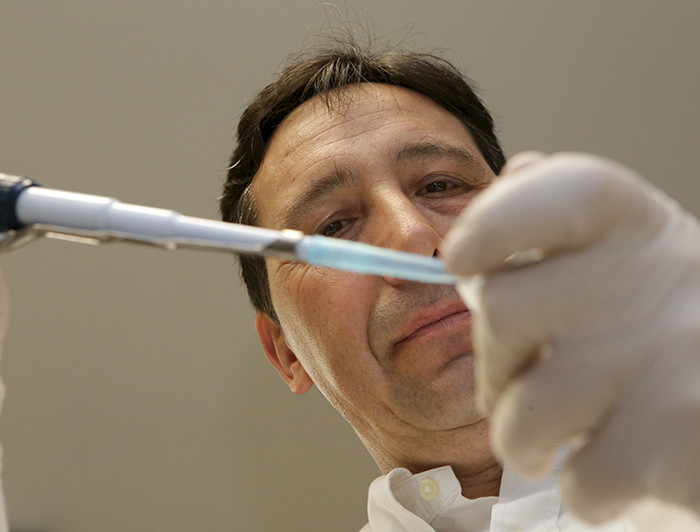
The Vaccine Against Covid-19 Being “Made in Chile”
The world is frantically looking for a vaccine that will prevent infections of the novel coronavirus. Among the more than 100 research teams trying to develop the world’s most sought-after vaccine is a Chilean crew led by Biological Sciences professor Alexis Kalergis and backed by the COVID-19 UC Social Roundtable, the University’s effort to contribute to the country’s policies seeking to contain the pandemic.

photo_camera Alexis Kalergis has developed vaccines against the respiratory syncytial virus and the metapneumovirus. Credit: César Cortés
When will the Covid-19 vaccine be ready?
That is the question that millions of people around the world are asking. Among them is Alexis Kalergis, a professor at the College of Biological Sciences, director of the Millennium Institute of Immunology and Immunotherapy (IMII) and researcher at the Consortium in Clinical-Molecular Biomedicine Technological Consortium (BMRC).
He’s been collecting information on Covid-19 since December. At first it seemed to be a new type of SARS, the severe acute respiratory syndrome that emerged in China in late 2002, which reached some 20 countries with a mortality rate of around 18%. Soon it became clear that Covid-19 was a different type of virus that quickly spread until it was declared a pandemic by the World Health Organization (WHO).
That’s when Kalergis had the idea of developing a vaccine.
It isn’t the first time that Kalergis and his team work on a vaccine. In fact, they created a vaccine against the syncytial virus, the leading cause of respiratory infectious diseases among infants and children. Their vaccine is the only one of its kind in the world that can be applied to newborns, and it has earned the team a series of accolades in Chile and abroad.
Developing the vaccine was a 15-year process that led to the creation of a second vaccine, this time targeting the metapneumovirus, which causes respiratory infections that lead to pneumonia. It’s currently being manufactured to produce 25,000 doses for the United States.
All of these experiences are the basis of their current efforts to find a vaccine for the novel coronavirus.
Since January, Kalergis and his team have embarked on the task of creating a national vaccine against Covid-19. The potential treatment consists of “SARS-CoV-2 proteins or protein fragments, deduced from its genetic material, which we choose according to its ability to induce a favorable immune response to eliminate the virus in the absence of excessive inflammation," he says.
The team is currently testing four vaccine formulations using these proteins, “which basically consist of different combinations of the selected proteins together with molecules that induce the immune response. One of them is a strategy equivalent to the one we successfully used to develop the vaccine against the respiratory syncytial virus,” says the academic.
Young scientists from UC are playing an important role in the project. “They’ve shown commitment and dedication, and see this investigation as a way of bringing scientific knowledge and their college work closer to the public," he adds.
Jorge Soto, Angello Retamal, Gisela Canedo, Mariana Ríos, Daniela Rivera and Alejandro Piña are the young University scientists putting their intellect and expertise to work in finding the prototype of the vaccine.
Katia Abarca from the College of Medicine, José Vicente González from the College of Chemistry, and Susan Bueno and Pablo González from the College of Biological Sciences are also participating as part of the UC academic team supporting the project.
The Long Road to a Vaccine
"It’s important to be very clear that these processes take time and require a series of preclinical and clinical studies that must comply with pretty strict regulations," Kalergis says.
With over 2 million confirmed cases globally and about 140,000 deaths, the toll grows daily as the whole world waits for scientists to find a vaccine.
The race to find immunity from Covid-19 began as soon as Chinese scientists sequenced the genome of the virus and shared it with the rest of the world. As of April 8, there were 115 projects under way in different stages of development to find a vaccine, according to scientific journal Nature.
How to Develop a Vaccine
Generally, the process involves making the vaccine’s construct or prototype to produce the viral antigens to be attacked by the immune system. The prototype is then tested on animals to ensure its effectiveness and safety. Once that is established, clinical trials on humans can proceed. And if it produces the expected immune reaction and protection, only then does it move into mass production.
"The formulation’s design and development is fairly standard, as we’ve previously developed other vaccines for respiratory viruses in the lab,” says Dr. Kalergis.
“The most challenging aspect will come once you have the formulation and establish that, at the laboratory level, the vaccine induces immunity. At that stage, it’s necessary to generate doses in conditions suitable for use in humans in accordance with national and international regulations.”
Development of a vaccine is expected to take several months, according to the BBC. To make matters more difficult, “there are no human vaccine production plants in Chile so it must be done abroad,” says Kalergis.
“When they are secured, you need to carry out a series of tests to verify the safety and ability to induce immunity. Then come other very challenging stages, which are the clinical trials.”

The Importance of Having a National Scientific Community
While Kalergis' team is "competing" in the international race against Covid-19, the techniques differ around the world. "The other vaccines that are being tested have different formulations," says the academic.
"For example, the vaccines that are currently in clinical studies are based on immunization with genetic material of the virus (DNA or RNA). In our case, we rely on the use of virus proteins and with different immunization strategies than those used in vaccines created by other research groups."
In addition, he explains, "We have combined the concept of traditional immunity with the induction of trained immunity. This comes from previous studies carried out by our group, in which we have shown that trained immunity can contribute to reducing the susceptibility to disease caused by respiratory viruses.”
But it is worth asking: If some research teams have already announced human trials, and with the possibility of commercial production in the near term, why launch a national vaccine program now?
“Many vaccines turn out to be unsuccessful in the clinical trial stage, or the vaccines induce weak immunity or are not appropriate for all populations. Therefore, it’s important to work on alternatives that originate from the creativity of our researchers. If any of these vaccines were successful and licensed for use, it does not mean that efforts to generate alternative vaccines should be stopped. This virus is new and we cannot predict its behavior. It’s possible that the virus may change in the future and available vaccines will stop working, and it may be necessary to use different strategies to induce immunity.”
Furthermore, “it's important to highlight that the national development of vaccines is a strategy that we must promote to ensure that our population has access to these health tools, which are critical to the wellbeing of citizens. Relying exclusively on the import of vaccines developed in other countries exposes us to situations of deprivation and inequality, which have at times affected our population,” says Kalergis.
UC Joins the Fight Against Covid-19

In late March, the Government established the Covid-19 Social Roundtable to coordinate a national policy addressing the coronavirus crisis. The group consists of government officials, mayors, academics and health authorities. Among them is UC President Ignacio Sánchez.
To support this work, the University created the COVID-19 UC Social Roundtable, a working group led by the Office of the Vice President for Research in coordination with other universities, institutions, the private sector and NGOs. As its general coordinator, the Vice President for Research, Pedro Bouchon, explains: "We’re contributing in various areas that aim to provide concrete solutions to address the challenges posed by this pandemic."
The aim is to obtain short-term results, including personal protective equipment and medical ventilators, community-based mass testing programs linked to primary care centers that can be scaled nationally, as well as strategies to amplify the capabilities of existing diagnostic equipment.
"We’re also contributing by drafting short- and long-term economic, mental health and education policies, and projects with a broad impact such as developing this vaccine, which is progressing steadily, though it has a long way to go,” says Bouchon.
“We’re strongly backing this project along with the director of Transfer & Development, Álvaro Ossa, as a lot of support is required in the relevant stages to come."
Kalergis adds: “From the beginning, UC has supported all of our lab’s initiatives to develop vaccines. We have the support of professors from the College of Biological Sciences, the College of Medicine and also from the Office of Transfer & Development, and the Office of the Vice President for Research, which have put all of their capacity at our disposal to support the progress of this research.”
Likewise, Kalergis highlights the contribution made by young scientists as part of their undergraduate, PhD, and postdoctoral studies programs, and “who with great enthusiasm, capacity, and dedication have made it possible for us to soon have the R+D results necessary to scale to the next stage.”
He also emphasizes the work of the UC Ethical-Scientific Committees and the Center for Innovation in Experimental Biomedical Models (CIBEM), as well as the administrative teams that participate in the project.


